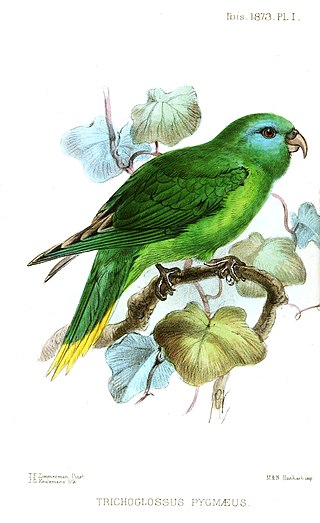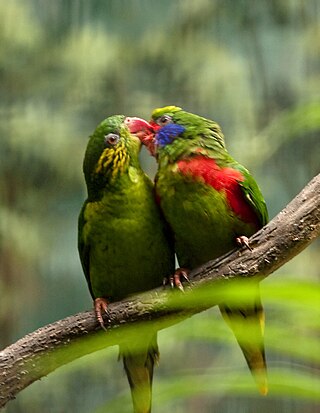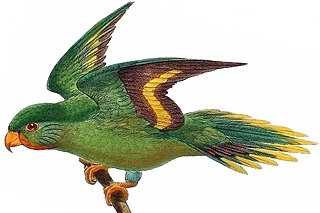
Loriinae is a subfamily of psittacine birds, one of the six subfamilies that make up the family Psittaculidae. It consists of three tribes, the lories and lorikeets (Loriini), the budgerigar (Melopsittacini) and the fig parrots (Cyclopsittini), which are small birds, mostly of bright colors and inhabitants of Oceania and the islands of Southeast Asia.

The New Caledonian lorikeet is a potentially extinct lorikeet endemic to the Melanesian island of New Caledonia.

The red-throated lorikeet is a critically endangered lorikeet endemic to Fiji. It is 18 cm long and is bright green overall, with red cheeks, throat and thighs.
The blue-fronted lorikeet also known as the Buru lorikeet, is a parrot endemic to the Indonesian island of Buru.

Vini is a genus of birds in the family Psittaculidae that are endemic to the islands of the tropical Pacific. There are eleven extant species of these small lorikeets ranging from the Bismark Archipelago through Fiji, Samoa, French Polynesia, and as far east as Henderson Island. All members of the genus have exceptional bright plumage, particularly the unusual all over blues of the blue lorikeet and the ultramarine lorikeet.

Charmosyna is a genus of parrots in the family Psittaculidae. The three currently recognized species inhabit moist forests on the island of New Guinea.

The duchess lorikeet is a species of parrot in the family Psittaculidae. It is the only species placed in the genus Charmosynoides. It is found throughout the Solomon Islands archipelago. Its natural habitats are subtropical or tropical moist lowland forest, subtropical or tropical moist montane forest, and plantations. It is threatened by habitat loss.
Meek's lorikeet is a species of parrot in the family Psittaculidae. It is found on Bougainville Island in Papua New Guinea and the Solomon Islands. Its natural habitats are subtropical or tropical moist lowland forest and subtropical or tropical moist montane forest. It is threatened by habitat loss.
The striated lorikeet, lori strié, or lori estriado is a species of parrot in the family Psittaculidae native to New Guinea. It is the only species placed in the genus Synorhacma. It is threatened by habitat loss.

The palm lorikeet is a species of parrot in the family Psittaculidae. It is found in the Santa Cruz Islands and Vanuatu. Its natural habitats are subtropical or tropical moist lowland forest, subtropical or tropical moist montane forest and plantations. It is threatened by habitat loss.

The red-flanked lorikeet is a species of parrot in the family Psittaculidae. It is found in Mollucas, New Guinea and the Bismarck Archipelago. Its natural habitats are subtropical or tropical moist lowland forests and subtropical or tropical mangrove forests. Only the adult males have the red plumage on the head and sides.

The fairy lorikeet is a species of parrot in the family Psittaculidae. Other common names include the little red lorikeet and the little red lory. Found in New Guinea, its natural habitats are subtropical or tropical moist lowland forests and subtropical or tropical moist montane forests. Its colouration is mainly red with some yellow on the throat and green on the wings. Two subspecies are recognised, C. p. pulchella and C. p. rothschildi.

The red-chinned lorikeet is a species of parrot in the family Psittaculidae. It is native to New Britain, New Ireland, New Hannover and Karkar Island in Papua New Guinea.

The red-fronted lorikeet, also known as the red-spotted lorikeet or red-rumped lorikeet is a species of parrot in the family Psittaculidae. It is found in northern New Guinea and the island of Biak. Its natural habitat is subtropical or tropical moist montane forests.

The pygmy lorikeet is a species of parrot in the family Psittaculidae. It is the only species placed in the genus Charminetta. It is found in the highlands of New Guinea; its natural habitat is subtropical or tropical moist montane forests. The world population of pygmy lorikeets is thought to be less than 50,000 individuals, but stable. They live at altitudes of 1000–2200m.

The plum-faced lorikeet, also known as the whiskered lorikeet, is a species of parrot in the family Psittaculidae. It is monotypic within the genus Oreopsittacus. It is found in the New Guinea Highlands.

Goldie's lorikeet is a species of parrot in the family Psittaculidae. It is the only species placed in the genus Glossoptilus. It is found in forest and woodland in New Guinea, primarily at altitudes of 1000–2200 m. It is mostly green with yellowish streaks in the chest area, and a red, blue and purple head. It is a small bird measuring 19 cm in length and weighing 45–60 grams.

Trichoglossus is a genus of lorikeet in the Psittaculidae or true parrot superfamily. The genus is distributed widely through Australia, Wallacea and Melanesia, with outliers in the Philippines and Micronesia. Members of the genus are characterised by barring, sometimes prominently, on the upper breast.

Saudareos is a genus of parrot in the family Psittaculidae. Species identified within this genus include lorikeets from the Philippines and Indonesia.

Hypocharmosyna is a genus of parrots in the family Psittaculidae that are endemic to New Guinea, the Maluku Islands and the Bismarck Archipelago.
















